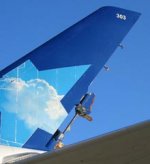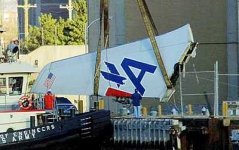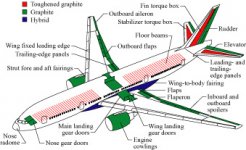jackinnj said:It goes without saying that the Airbus is a wonderful plane to fly -- at least according to one of my friends who is a former USAF pilot and now working with Northwest. They were the first to perfect "fly-by-wire" in the commercial market.
the newer AirBus airplanes are considerably nicer than their Boeing equivalent. Creature comfort wasn't much of a factor for Boeing and their suppliers.
Boeing made a conscious decision not to deploy FBW. AirBus, being a new entrant and upcoming kid, was more willing to take risks. That is also reflected in their use of composites in their aerostructures.
Mark A. Gulbrandsen said:I really dislike those planes.
Get a flight in some 25-years old TU-154 or IL-62 and you'll love AIRBUS, rest assured!
That is also reflected in their use of composites in their aerostructures.
Or perhaps better stated in their mis-use of composites..... This is something that has not happened to a Boeing plane using composites at the moment.
Boeing made a conscious decision not to deploy FBW.
Ha, The 777 which has a perfect safety record is all FBW. The difference between the two could be said that Boeing is digital fly by wire and Airbus is fly by computer, you guys go figure which is the better design
 .
."The new technologies in flight control avionics systems selected for the Boeing 777 airplane program consist of the following: Fly-By-Wire (FBW), ARINC 629 Data Bus, and Deferred Maintenance.The FBW must meet extremely high levels of functional integrity and availability. The heart of the FBW concept is the use of triple redundancy for all hardware resources: computing system, airplane electrical power, hydraulic power and communication paths.The multiple redundant hardware are required to meet the numerical safety requirements. Hardware redundancy can be relied upon only if hardware faults can be contained; fail-passive electronics are necessary building blocks for the FBW systems. In addition, FBW computer architecture must consider other fault tolerance issues: generic errors, common mode faults, near-coincidence faults and dissimilarity."
Mark
Attachments
the newer AirBus airplanes are considerably nicer than their Boeing equivalent. Creature comfort wasn't much of a factor for Boeing and their suppliers.
That may be true. With Boeing it seems that the first order of the day is to make the plane fly reliably, then came in what ever creature comforts could be fit into what ever space was left. In the 767, and 777 there are plenty of creature comforts at least on the planes I've flown on.
That is also reflected in their use of composites in their aerostructures.
Sadly......More Airbus "composites".
Attachments
Mark A. Gulbrandsen said:Or perhaps better stated in their mis-use of composites..... This is something that has not happened to a Boeing plane using composites at the moment.
Boeing hadn't used composites in aerostructures - until the dreamliner. That, coupled with AirBus' stellar flight safety, tells me that composites are more than adequate, even in aerostructures.
Mark A. Gulbrandsen said:The difference between the two could be said that Boeing is digital fly by wire and Airbus is fly by computer, you guys go figure which is the better design.
Boeing is also fly-by-computer in later models (your 777 included. It did have mechanical redundant systems earlier on but has abandoned that approach).
The difference is that Boeing allowed overriden of some limits where AirBus doesn't.
I am not sure if there is a clear winner here as both sides have some valid arguments. If the pilot mistakenly puts the plane into abrupt and dangerous maneover, the AirBus system will take over and avoid an accident, while the Boeing plane would have crashed. With my experience on TMI, i would go with the AirBus approach but I clearly say why others would prefer the Boeing approach.
Mark A. Gulbrandsen said:Sadly......More Airbus "composites".
I believe the nTSB faulted AA's pilot training for that crash. And AA has since changed its training as a result of that.
Boeing is also fly-by-computer in later models (your 777 included. It did have mechanical redundant systems earlier on but has abandoned that approach).
Well, thats not what Boeing calls it. Their term is "Digital fly by wire" and is a VERY different system than Airbus's computer controled fly by wire system. The Airbus system has led to several crashes whilst pilots were dymbfounded as to why they could not control theor plane. The Boeing system doesn't allow this sort of thing to happen. There is an interesting example of a confused FO here
Absolutely, The training was changed to prevent the loading on the tail that was caused by that manuver. Hhowever the second officer who was flying at the time obviously had done that trick before.... And its obvious that composites just can't take the load at this point in time of aorframe technology. Perhaps they went to composites a little too soon. Had the tail been alumnium that plane would have kept on flying and no one would have even known what the the 2nd officer did. I think Boeing was the wiser manufacturer approaching composites much more cautiously untuil they developed a grip on the technology.
There are alot of composite parts in both the 767 and 777, some of them significent structural parts and the number of parts vary between planes. Here are some of them
Well, thats not what Boeing calls it. Their term is "Digital fly by wire" and is a VERY different system than Airbus's computer controled fly by wire system. The Airbus system has led to several crashes whilst pilots were dymbfounded as to why they could not control theor plane. The Boeing system doesn't allow this sort of thing to happen. There is an interesting example of a confused FO here
I believe the nTSB faulted AA's pilot training for that crash. And AA has since changed its training as a result of that.
Absolutely, The training was changed to prevent the loading on the tail that was caused by that manuver. Hhowever the second officer who was flying at the time obviously had done that trick before.... And its obvious that composites just can't take the load at this point in time of aorframe technology. Perhaps they went to composites a little too soon. Had the tail been alumnium that plane would have kept on flying and no one would have even known what the the 2nd officer did. I think Boeing was the wiser manufacturer approaching composites much more cautiously untuil they developed a grip on the technology.
There are alot of composite parts in both the 767 and 777, some of them significent structural parts and the number of parts vary between planes. Here are some of them
Attachments
Mark A. Gulbrandsen said:The Airbus system has led to several crashes whilst pilots were dymbfounded as to why they could not control theor plane. The Boeing system doesn't allow this sort of thing to happen.
I can assure you that if the Boeing system could have prevented that from happening, there would be no market for AirBus, 🙂. Just ask those avonics makers.
Mark A. Gulbrandsen said:There is an interesting example of a confused FO here
Looks like to have lots of pilot errors. BTW, the author incorrectly identified that flight as China Air when in fact it is Air China (they are two different carriers. confusing, isn't it?).
Mark A. Gulbrandsen said:Had the tail been alumnium that plane would have kept on flying
that's pure speculation that NTSB didn't agree, AirBus didn't agree, Boeing didn't agree, and the pilots union didn't agree, nor did the flying public.
I wouldn't go that far, nor would Boeing that's why the 787 had tons of composites, even in aerostructural parts.
Again, there are pros and cons to both approaches and we are not at a point where we can conclude the superiority of either.
- Status
- Not open for further replies.
- Home
- Member Areas
- The Lounge
- Thank you AIRBUS



